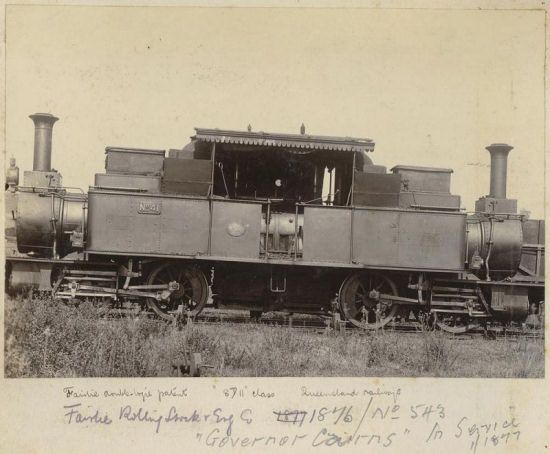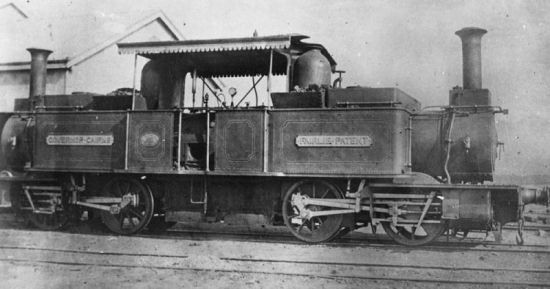Queensland Railways 8D11 Class Loco

The old saying of ‘once bitten twice shy’ comes to mind when I look at this loco because it wasn’t the first Double Fairlie loco that came to Queensland and the experience the Railways had with the first Double Fairlie was enough to make them want to never see another one.
Queensland was one of the first to order Double Fairlies for their railway. The concept of the Double Fairlie … designed by Robert Fairlie … is that two engines, each with their own boiler, can share a singe firebox.
The concept did work for most purchasers … including Queensland but not with the first three locos that arrived. These locos had an 0-6-6-0 wheel arrangement and were ordered from the not-so-well-known loco building firm of James Cross of St Helens in England.
Three locos were delivered in kit form in 1867. One was assembled for testing and immediately there was a problem … the locomotive was 6 tons overweight. However the Queensland Railways had invested Government money in these locos so tests had to be carried out.
Those tests didn’t last long. On the first day the loco was steamed and sent with a small test train towards Toowoomba. 38km later the test was over and the loco was being hauled back to the workshops.
In that first 38km the text loco had run out of water, had spread the rails on some of the tight curves on the line and finally derailed. Oh and in spreading the rails it had also managed to shear chunks of iron off the inside of the rails.**
After some discussion with the manufacturers the loco was packed back into its crate and it and the other two locos were shipped back to the manufacturer.
9 years later another Double Fairlie arrived in Brisbane. This time it was built as an 0-4-4-0 by the Vulcan Foundry (builders no. 543 of 1876). After trials on the Toowoomba Range … the range the earlier locos failed to reach … the loco was purchased and named ‘Governor Cairns’.
Unfortunately it was set aside in 1870 due to problems with its flexible steam pipe but 10 years later it was back in service working out of Brisbane over lines that did not have such tight curves as the line over the Toowoomba Range had. Even on these easier lines the loco continued to have problems
In 1882 it was given the number 41 and in 1889 it was designated as the 8D11 class. When expensive boiler repairs became necessary in 1902 the loco was written off and scrapped.

Technical details
| Wheel arrangement | 0-4-4-0 |
| Driving wheel diameter | 36in |
| Boiler pressure | 110lb |
| Cylinders | 4 11x8in |
| Tractive effort | 10,648lb |
| Weight | 36 tons |
**On Saturday 18 January 1868 The Queenslander published the following letter from the Queensland Locomotive Superintendent who had accompanied the locomotive on original Double Fairlie trial:
“THE following correspondence has been laid before Parliament: Southern and Western Railway, Locomotive Department,
Ipswich, January 6, 1868. Sir, I have the honor to inform you that the Engineer-in-Chief and myself, yesterday, took out the first Main Range engine for trial.
I recommended this to be done on Sunday, as the line would then be clear ; a pilot engine was coupled on, but not allowed to assist unless required.
We remarked that Cross and Co.’s engine ran very heavily, and caused the timber bridges to spring.
On arrival at Grandchester, the tanks were quite empty, showing that if the engine had been loaded it would have run short of water in a distance of twenty-one miles.
After filling the tanks, we proceeded up the Liverpool Range, the engine losing4olbs. pressure of steam in the first two miles. This might be partly accounted for by the uneven beat of the valves,two of them working badly through the play in the link motion.
The tyres were grinding heavily on the curves, one on being gauged was found to be three-sixteenths of an inch wide after the engine had passed over ; the rail on higher side being bent outwards.
The engine proceeded slowly as far as twenty-three miles forty chains, where it ran off the line on a six chain curve, the gradient being one in eighty, ascending. All being on the alert, it was quickly stopped, but the spot was awkward, as we were approaching a high bank.
I remarked that the bogys of the engine swivelled, but that the whole weight upon them is so great that the rails are bent outwards by the thrust necessary to cause the bogys to adapt themselves to the curves.
I am fully convinced that these engines are wholly unsuited for this line, both on account of their excessive weight (thirly-eight tons four hundred weight in working order), and on account of the bad design and workmanship.
The enginemen and firemen suffered severely from the heat, their clothes being thoroughly saturated with perspiration. I do not think men could work engines made as these are in this climate.
I have, etc, J. F. L. Jettee, Locomotive Superintendent. A. O. Herbert, Esq., Commissioner for Railways, Brisbane”
On the same day the same paper also published a letter from Henry T Plews, the Engineer in Chief who wrote to add extra detail to the Locomotive Superintendent’s letter.
In relation to the problems experienced on the tight curves he said “On the sharp re- verse curves, the grind of the leading wheels upon the outer rail was very great, and large flakes of iron were torn from the rails and tires.”
The loco also had quite an effect on the bridges on the line. “… the yielding of some of the timber bridges and culverts when passing over them, was quite perceptible.”
And when it came to the derailment he reported that:
“On reaching 23 miles 48.90 chains, where the line is curved to a radius of six chains upon a high embankment, and with a rising gradient of one in eighty, the leading wheels mounted the outside rail, and before the engine could be stopped it left the rails and ran with the four front wheels on the ballast and sleepers for thirty or forty yards. The reversing gear, I may here mention, works very slowly, twenty-six turns of a screw being required before the engine can be reversed. The rails for some distance back were very much crippled and bent, and the road widened out of gauge.”
Mr Plews also had some interesting comments about what he thought would need to be done to the loco before it could be used in service and about conditions for the crew.
“Larger and better arranged water tanks and fuel boxes will have to be made, and, in fact, numerous other alterations and improvements, amounting almost to a re-construction of the engines, will be required before they can be used at all.
The water tanks are so constructed that there are no exits for the confined air, and the orifices for filling them with water are so narrow and straightened, that ten minutes to a quarter of an hour is lost at each watering place in filling the tanks, this alone precludes the use of the engine for ordinary traffic.
These tanks and fuel boxes are also so placed that the unfortunate drivers and firemen are boxed up in small cells where they cannot see the road in front or the train behind ; where they have no current of air, and with a blazing fire in front, and a fierce sun above and behind them, the heat during summer will be too intense for them to bear.”
References
Photos courtesy of State Library of Queensland
The Queenslander Newspaper of 18 January, 1868
Technical details: Locomotives of Australia 1880s~1990s, Third Edition, Oberg, Leon, Kangaroo Press, 1996